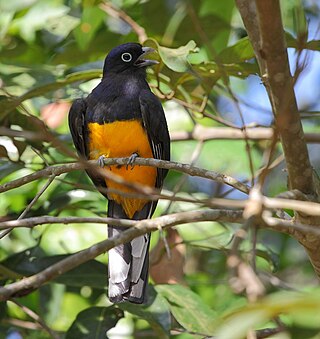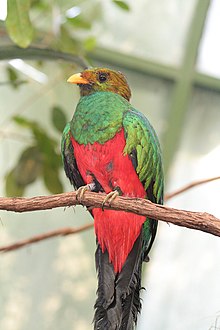
The trogons and quetzals are birds in the order Trogoniformes which contains only one family, the Trogonidae. The family Trogonidae contains 46 species in seven genera. The fossil record of the trogons dates back 49 million years to the Early Eocene. They might constitute a member of the basal radiation of the order Coraciiformes and order Passeriformes or be closely related to mousebirds and owls. The word trogon is Greek for "nibbling" and refers to the fact that these birds gnaw holes in trees to make their nests.

Quetzals are strikingly colored birds in the trogon family. They are found in forests, especially in humid highlands, with the five species from the genus Pharomachrus being exclusively Neotropical, while a single species, the eared quetzal, Euptilotis neoxenus, is found in Guatemala, sometimes in Mexico and very locally in the southernmost United States. In the highlands of the states of Sonora, Chihuahua, Sinaloa, Durango, Nayarit, Zacatecas, Jalisco, and Michoacán, the eared quetzal can be found from northwest to west-central Mexico. It is a Mesoamerican indigenous species, but some reports show that it occasionally travels and nests in southeastern Arizona and New Mexico in the United States. June to October is the mating season for eared quetzals. Quetzals are fairly large, slightly bigger than other trogon species. The resplendent quetzal is the national bird of Guatemala because of its vibrant colour and cultural significance to the Maya.

The Guianan trogon, is a near passerine bird in the trogon and quetzal family Trogonidae. It is found in Brazil, French Guiana, Guyana, Suriname, Trinidad, and Venezuela.

The resplendent quetzal is a small bird found in Central America and southern Mexico that lives in tropical forests, particularly montane cloud forests. They are part of the family Trogonidae and have two recognized subspecies, P. m. mocinno and P. m. costaricensis. Like other quetzals, the resplendent is mostly omnivorous; its diet mainly consists of fruits of plants in the laurel family, Lauraceae, but it occasionally also preys on insects, lizards, frogs and snails.

The rifleman is a small insectivorous passerine bird that is endemic to New Zealand. It belongs to the family Acanthisittidae, also known as the New Zealand wrens, of which it is one of only two surviving species. The rifleman resembles a wren in form, but is not related to the family of true wrens, Troglodytidae, nor the fairy-wrens of Australia.

The Amazonian black-throated trogon is a bird in the trogon family, Trogonidae. Although it is also called "yellow-bellied trogon" it is not the only trogon with a yellow belly. It breeds in lowlands of Amazonia.

The eared quetzal, also known as the eared trogon, is a near passerine bird in the trogon family, Trogonidae. It is native to streamside pine-oak forests and canyons in the Sierra Madre Occidental of Mexico south to western Michoacán, and southeasternmost Arizona and New Mexico in the United States. This range includes part of the Madrean Sky Islands region of southeastern Arizona, southwestern New Mexico, and northern Sonora.

The bar-tailed trogon is a species of bird in the family Trogonidae. It is a resident bird to central Africa that eats primarily insects and fruit.

The red-headed trogon is a species of bird in the family Trogonidae.

The red-naped trogon is a species of bird in the family Trogonidae. It is found in Brunei, Indonesia, Malaysia, and Thailand. Its natural habitat is subtropical or tropical moist lowland forests. It is threatened by habitat loss.

The orange-breasted trogon is a species of bird in the family Trogonidae. It is a colorful, sedentary species that inhabits the lower canopy of the lowlands and forest of southern China, southeast Asia, Borneo, Sumatra and Java.

Whitehead's trogon is a species of bird in the family Trogonidae. It is endemic to the island of Borneo, where it is an uncommon resident in primary mountain forest. One of Borneo's largest trogons at 29 to 33 cm long, it is sexually dimorphic. The male is crimson on the head, nape, and underparts, with a black throat and grey chest; the rest of his upperparts are cinnamon-coloured. The female is similarly patterned, but cinnamon-brown where the male is scarlet. The species was first described for science by Richard Bowdler Sharpe in 1888, who named it for British explorer and collector John Whitehead. There are no subspecies.

The crested quetzal /ketSAHL/ is a species of bird in the family Trogonidae native to South America, where it is found in Bolivia, Colombia, Ecuador, Peru, and Venezuela. Its natural habitat is subtropical or tropical moist montane forests.

The white-tipped quetzal is a species of bird in the family Trogonidae found in Venezuela, Colombia, and Guyana. Two subspecies have been described. Pharomachrus fulgidus fulgidus is found in the mountains of northern Venezuela and Pharomachrus fulgidus festatus ranges through the Santa Marta mountains of northeast Colombia. Quetzals are iridescent and colourful birds found in forests, woodlands and humid highlands. The white-tipped quetzal has been a limited subject of research. Pharomachrus nests have been studied to analyse the effects of rainfall on breeding, however conclusions are based on single observations. On the IUCN Red list of threatened species, the white-tipped quetzal is listed as a species of least concern.

The pavonine quetzal is a species of bird in the family Trogonidae, the trogons. It is also known at the peacock trogon, red-billed train bearer, or viuda pico rojo in Spanish. The pavonine quetzal lives in the Neotropics, more specifically in the northern region of the Amazon basin, spreading from Colombia to Bolivia. The most notable characteristics helpful in identifying this bird are its plumage, red beak, and its distribution - it is the only quetzal occupying the lowland rainforest east of the Andes.

Baird's trogon is a bird species belonging to the family Trogonidae, which includes quetzals and trogons. It is native to Costa Rica and Panama. The species is named in honor of Spencer Fullerton Baird, a renowned naturalist of the 19th century who served as the first curator of the Smithsonian Institution.

The black-headed trogon is a species of bird in the family Trogonidae. It is found in Belize, Costa Rica, El Salvador, Guatemala, Honduras, Mexico, and Nicaragua.

The Ecuadorian trogon is a species of bird in the family Trogonidae, the quetzals and trogons. It is found in Ecuador and Peru.

The Amazonian trogon, is a species of bird in the family Trogonidae, the trogons and quetzals. It is found in Bolivia, Brazil, Colombia, Ecuador, Peru, and Venezuela.

The green-backed trogon, also known as the Amazonian white-tailed trogon, is a bird in the trogon family Trogonidae. It is widely distributed across the Amazon rainforest with a disjunct population on the southeast coast of Brazil. As with all trogons, this species is sexually dimorphic. The male has a yellow belly without a white breastband, a blue head with a pale-blue orbital eye-ring, a blue bill, a green back and a green tail that is mostly white below. The female is duller with a dark grey head, a dark grey back and some black barring beneath the tail.






















